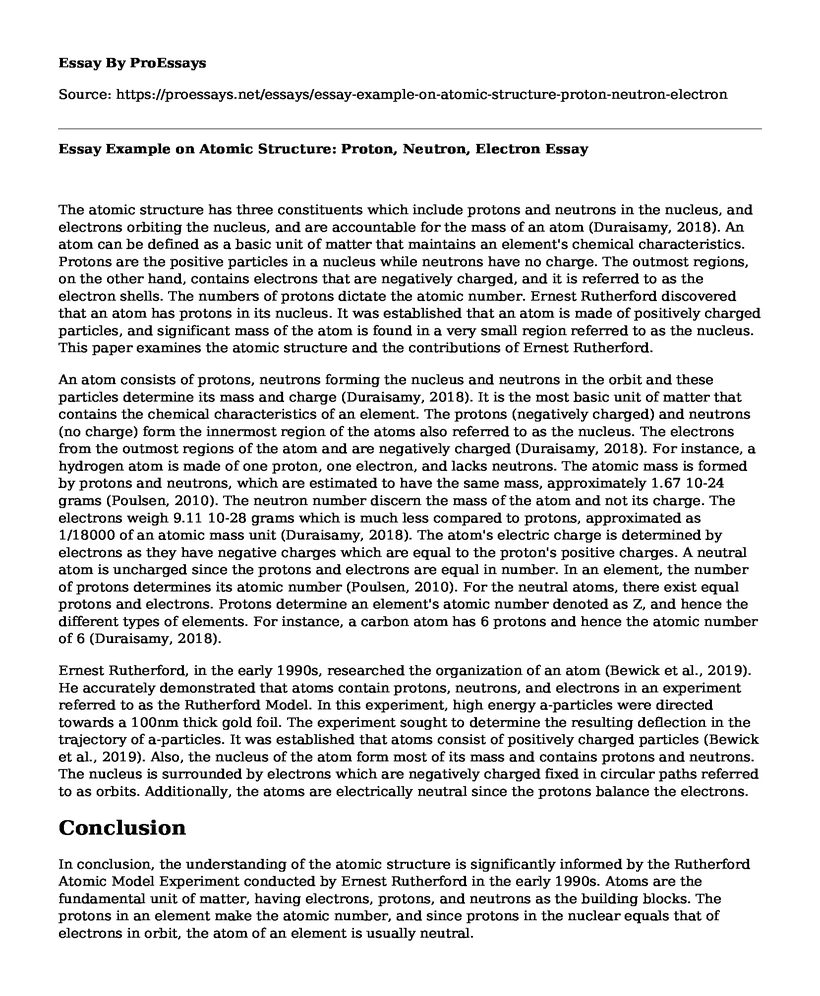The atomic structure has three constituents which include protons and neutrons in the nucleus, and electrons orbiting the nucleus, and are accountable for the mass of an atom (Duraisamy, 2018). An atom can be defined as a basic unit of matter that maintains an element's chemical characteristics. Protons are the positive particles in a nucleus while neutrons have no charge. The outmost regions, on the other hand, contains electrons that are negatively charged, and it is referred to as the electron shells. The numbers of protons dictate the atomic number. Ernest Rutherford discovered that an atom has protons in its nucleus. It was established that an atom is made of positively charged particles, and significant mass of the atom is found in a very small region referred to as the nucleus. This paper examines the atomic structure and the contributions of Ernest Rutherford.
An atom consists of protons, neutrons forming the nucleus and neutrons in the orbit and these particles determine its mass and charge (Duraisamy, 2018). It is the most basic unit of matter that contains the chemical characteristics of an element. The protons (negatively charged) and neutrons (no charge) form the innermost region of the atoms also referred to as the nucleus. The electrons from the outmost regions of the atom and are negatively charged (Duraisamy, 2018). For instance, a hydrogen atom is made of one proton, one electron, and lacks neutrons. The atomic mass is formed by protons and neutrons, which are estimated to have the same mass, approximately 1.67 10-24 grams (Poulsen, 2010). The neutron number discern the mass of the atom and not its charge. The electrons weigh 9.11 10-28 grams which is much less compared to protons, approximated as 1/18000 of an atomic mass unit (Duraisamy, 2018). The atom's electric charge is determined by electrons as they have negative charges which are equal to the proton's positive charges. A neutral atom is uncharged since the protons and electrons are equal in number. In an element, the number of protons determines its atomic number (Poulsen, 2010). For the neutral atoms, there exist equal protons and electrons. Protons determine an element's atomic number denoted as Z, and hence the different types of elements. For instance, a carbon atom has 6 protons and hence the atomic number of 6 (Duraisamy, 2018).
Ernest Rutherford, in the early 1990s, researched the organization of an atom (Bewick et al., 2019). He accurately demonstrated that atoms contain protons, neutrons, and electrons in an experiment referred to as the Rutherford Model. In this experiment, high energy a-particles were directed towards a 100nm thick gold foil. The experiment sought to determine the resulting deflection in the trajectory of a-particles. It was established that atoms consist of positively charged particles (Bewick et al., 2019). Also, the nucleus of the atom form most of its mass and contains protons and neutrons. The nucleus is surrounded by electrons which are negatively charged fixed in circular paths referred to as orbits. Additionally, the atoms are electrically neutral since the protons balance the electrons.
Conclusion
In conclusion, the understanding of the atomic structure is significantly informed by the Rutherford Atomic Model Experiment conducted by Ernest Rutherford in the early 1990s. Atoms are the fundamental unit of matter, having electrons, protons, and neutrons as the building blocks. The protons in an element make the atomic number, and since protons in the nuclear equals that of electrons in orbit, the atom of an element is usually neutral.
References
Bewick, S., Parsons, R., Forsythe, T., Robinson, S., & Dupon, J. (2019). 4.13: Rutherford's Atomic Model. Retrieved 1 October 2019, from https://chem.libretexts.org/Bookshelves/Introductory_Chemistry/Book%3A_Introductory_Chemistry_(CK-12)/04%3A_Atomic_Structure/4.13%3A_Rutherford%27s_Atomic_Model
Duraisamy, R. (2018). Atomic Structure & Basic Concepts of Chemistry. Retrieved 1 October 2019, from https://www.researchgate.net/publication/326460294_Atomic_Structure_Basic_Concepts_of_Chemistry#pfa
Poulsen, T. (2010). Introduction to Chemistry. Retrieved 1 October 2019, from https://openedgroup.org/books/Chemistry.pdf
Cite this page
Essay Example on Atomic Structure: Proton, Neutron, Electron. (2023, Feb 20). Retrieved from https://proessays.net/essays/essay-example-on-atomic-structure-proton-neutron-electron
If you are the original author of this essay and no longer wish to have it published on the ProEssays website, please click below to request its removal:
- Uniform Motion Essay
- Colonizing Kepler 452-B Essay Example
- The Ideal Gas Law - Essay Sample
- Essay Sample on Organic Compounds: Benefits for Optoelectronic Devices
- Essay Sample on Math Education: Developing Procedural & Conceptual Understanding
- Chemical Industries: Properties, Uses, Hazards, and Safety Measures - Essay Sample
- Essay Example on Science: Explaining Phenomena and Practical Issues







